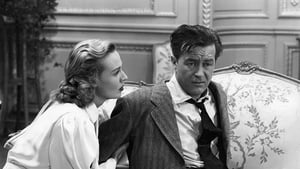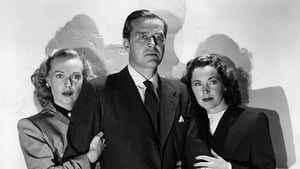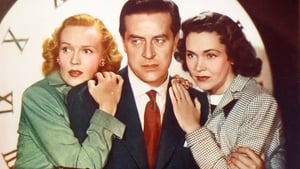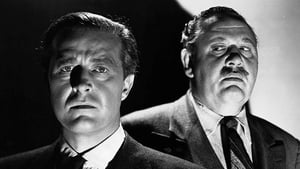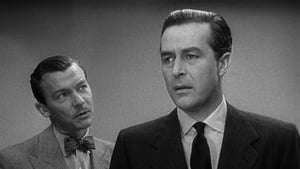Contact: info@alwanfilm.com
Video Sources 0 Views

Synopsis
Review: The Big Clock 1948 Colorized – Unveiling the Intricacies of Film Noir and Its Timeless Appeal

Introduction
In the realm of classic cinema, few genres are as distinct and captivating as film noir. Among its most intriguing examples is “The Big Clock 1948,” a seminal work that encapsulates the essence of the genre with its intricate plotting, dark atmosphere, and sharp dialogue. Directed by John Farrow and based on Kenneth Fearing’s novel, this film stands out not only for its compelling narrative but also for its innovative approach to the noir aesthetic. In this article, we will delve into the significance of “The Big Clock 1948,” exploring its impact on the genre, its memorable performances, and its place in the pantheon of classic films.
Check The Full Colorized Movies List
Check Our Colorized Movies Trailer Channel
Understanding The Big Clock 1948 Colorized: Director, Cast, and Genre
“The Big Clock 1948” emerges from the vision of director John Farrow, a filmmaker known for his ability to blend suspense with psychological intrigue. The film stars Ray Milland, whose portrayal of the protagonist is both nuanced and riveting. Joining him are a stellar cast including Charles Laughton, Maureen O’Sullivan, and Rita Johnson, each contributing to the film’s rich tapestry of deceit and drama.
The film noir genre, characterized by its cynical outlook, morally ambiguous characters, and stylistic flourishes, finds a perfect expression in “The Big Clock.” Farrow’s direction and the film’s sharp screenplay create a labyrinthine narrative that keeps audiences guessing until the final frame. With its shadowy cinematography and intricate plot twists, “The Big Clock” exemplifies the genre’s defining features, combining suspense, drama, and psychological depth.
Exploring the World of The Big Clock 1948 Colorized: Plot and Characters
At the heart of “The Big Clock 1948” is a suspenseful and intricate plot revolving around a murder mystery and a complex game of cat and mouse. The story follows George Stroud, played by Ray Milland, a successful magazine editor who becomes entangled in a web of deceit and danger after a one-night affair with a woman who is later found murdered.
The narrative unfolds with George Stroud being unwittingly drawn into the investigation of the very crime he is connected to, as he tries to unravel the mystery while avoiding becoming a prime suspect. The film’s plot is characterized by its tight pacing, clever twists, and a pervasive sense of paranoia that keeps viewers on edge.
Key characters include:
- George Stroud (Ray Milland): The protagonist, a man caught in a dire situation as he attempts to clear his name while investigating the murder he is secretly linked to.
- Evelyn Keyes (Rita Johnson): The enigmatic woman whose murder sets off the chain of events, adding layers of complexity to the story.
- Hugh Bennett (Charles Laughton): The manipulative and powerful publisher who plays a significant role in the unfolding drama, driving much of the film’s suspense.
- Janet (Maureen O’Sullivan): Stroud’s supportive yet unsuspecting wife, who becomes entangled in the unfolding mystery.
The Art of Film Noir
Film noir, a genre that emerged in the 1940s, is renowned for its distinctive style and thematic preoccupations. Characterized by its use of low-key lighting, deep shadows, and a stark visual contrast, film noir often explores themes of crime, corruption, and existential dread. The genre’s influence is evident in “The Big Clock 1948,” which employs these stylistic elements to create an atmosphere of tension and unease.
The visual style of film noir is complemented by its narrative structure, which often features morally ambiguous protagonists, femme fatales, and a pervasive sense of fatalism. In “The Big Clock,” these elements are skillfully employed to craft a suspenseful and engaging story that reflects the genre’s core attributes.
Early Film Noir: A Brief History
The origins of film noir can be traced back to the early 1940s, a period marked by a fascination with crime, psychological complexity, and urban decay. Influenced by hard-boiled detective fiction and the socio-political climate of the time, early film noir films explored themes of corruption, betrayal, and moral ambiguity.
The genre’s defining characteristics—such as its use of shadowy cinematography, convoluted plots, and morally complex characters—quickly became staples of noir cinema. As filmmakers experimented with these elements, film noir evolved into a distinct and influential genre, leaving a lasting impact on the world of cinema.
The Big Clock 1948 and Its Noir Legacy
“The Big Clock 1948” occupies a notable place in the film noir canon, reflecting the genre’s fascination with crime and psychological tension. Its clever narrative, atmospheric cinematography, and strong performances contribute to its status as a classic example of noir filmmaking.
The film’s impact on the genre is evident in its innovative approach to storytelling and character development. By blending elements of suspense, psychological drama, and crime fiction, “The Big Clock” offers a compelling and multifaceted exploration of the noir aesthetic. Its influence can be seen in subsequent films and television shows that draw on the genre’s signature style and themes.
The Debate Over Film Noir Interpretations
As with any genre, film noir is subject to various interpretations and debates among critics and scholars. While some view it as a reflection of post-war anxieties and moral uncertainties, others argue that it represents a broader exploration of human nature and existential themes.
The debate over film noir interpretations highlights the genre’s complexity and its ability to resonate with audiences on multiple levels. Whether seen as a critique of societal norms or a reflection of individual psychological struggles, film noir remains a rich and evocative genre that continues to captivate viewers.
Examining The Big Clock 1948 Colorized as a Film Noir Classic
Viewing “The Big Clock 1948” within the context of film noir offers insights into the genre’s defining features and its enduring appeal. The film’s use of shadowy cinematography, intricate plotting, and morally ambiguous characters exemplifies the core elements of noir filmmaking.
The early noir elements of “The Big Clock” are complemented by its strong performances and innovative storytelling. Ray Milland’s portrayal of George Stroud, in particular, captures the essence of the morally conflicted protagonist that is a hallmark of the genre. The film’s tense atmosphere and clever narrative twists contribute to its status as a classic example of film noir.
Influence and Legacy: The Big Clock 1948 Colorized’s Impact on Cinema
Beyond its immediate impact, “The Big Clock 1948” has left a lasting legacy in the world of cinema. Its influence can be seen in subsequent films and television shows that draw on the genre’s signature style and themes. The film’s innovative approach to storytelling and its strong performances continue to inspire filmmakers and captivate audiences.
The film’s impact is also reflected in its continued relevance within the film noir genre. As a classic example of noir filmmaking, “The Big Clock” remains an important reference point for understanding the genre’s evolution and its enduring appeal.
Director’s Cinematic Legacy: Beyond The Big Clock 1948 Colorized
John Farrow’s directorial legacy extends beyond “The Big Clock 1948,” encompassing a diverse body of work that spans various genres and styles. Known for his ability to craft suspenseful and engaging narratives, Farrow’s contributions to cinema have left a lasting impact on the industry.
Farrow’s work reflects a commitment to storytelling and a mastery of cinematic techniques. His films often explore themes of psychological tension and moral ambiguity, echoing the core elements of film noir and contributing to his reputation as a skilled and influential filmmaker.
Themes Explored in The Big Clock 1948 Colorized
At its core, “The Big Clock 1948” delves into themes of guilt, deception, and existential dread, painting a complex portrait of the human experience. Through its exploration of crime and moral ambiguity, the film offers a nuanced examination of the nature of justice and the consequences of one’s actions.
The film’s portrayal of the protagonist’s struggle to clear his name while navigating a web of deceit reflects broader themes of identity and self-discovery. By examining the interplay between truth and deception, “The Big Clock” invites viewers to contemplate the nature of reality and the challenges of navigating a morally complex world.
Reception and Controversy Surrounding The Big Clock 1948 Colorized
The release of “The Big Clock 1948” has been met with critical acclaim, with reviewers praising its suspenseful narrative, strong performances, and innovative approach to the film noir genre. However, like any classic film, it has also faced its share of controversies and debates.
Critics have highlighted the film’s ability to captivate and engage audiences through its clever plotting and atmospheric style. Despite occasional criticisms regarding certain narrative choices or character developments, “The Big Clock” remains a respected and influential example of film noir filmmaking.
Where to Watch The Big Clock 1948 Colorized Online
For those eager to experience the timeless brilliance of “The Big Clock 1948,” the film is available on various streaming platforms and digital formats. Its continued availability ensures that new generations of viewers can explore this classic example of film noir and appreciate its contributions to the genre.
FAQs About The Big Clock 1948 Colorized
Common queries surrounding “The Big Clock 1948” often focus on its historical context, thematic elements, and its place in the film noir genre. By addressing these frequently asked questions, viewers can gain a deeper understanding of the film’s significance and impact.
Q: What is the significance of the film’s title?
A: The title “The Big Clock” refers to the central motif of the film—the ticking clock that symbolizes the constant pressure and looming danger faced by the protagonist. It reflects the film’s themes of time, urgency, and the inevitability of consequences.
Q: How does “The Big Clock 1948” compare to other film noir films?
A: “The Big Clock 1948” stands out within the film noir genre for its intricate plotting, strong performances, and atmospheric style. While it shares many of the genre’s defining characteristics, its innovative storytelling and engaging narrative contribute to its status as a classic example of noir filmmaking.
Q: What are some notable elements of film noir found in “The Big Clock 1948”?
A: Notable elements of film noir in “The Big Clock 1948” include its use of shadowy cinematography, morally ambiguous characters, and a suspenseful narrative filled with twists and turns. The film’s dark atmosphere and exploration of themes such as guilt and deception are key aspects of the genre.
Conclusion
In conclusion, “The Big Clock 1948” remains a quintessential example of film noir, reflecting the genre’s fascination with crime, suspense, and psychological complexity. Its innovative storytelling, strong performances, and atmospheric style contribute to its enduring appeal and significance within the cinematic landscape. As we continue to explore the rich history of film noir, “The Big Clock” stands as a testament to the genre’s ability to captivate and engage audiences through its timeless exploration of human nature and existential themes.

